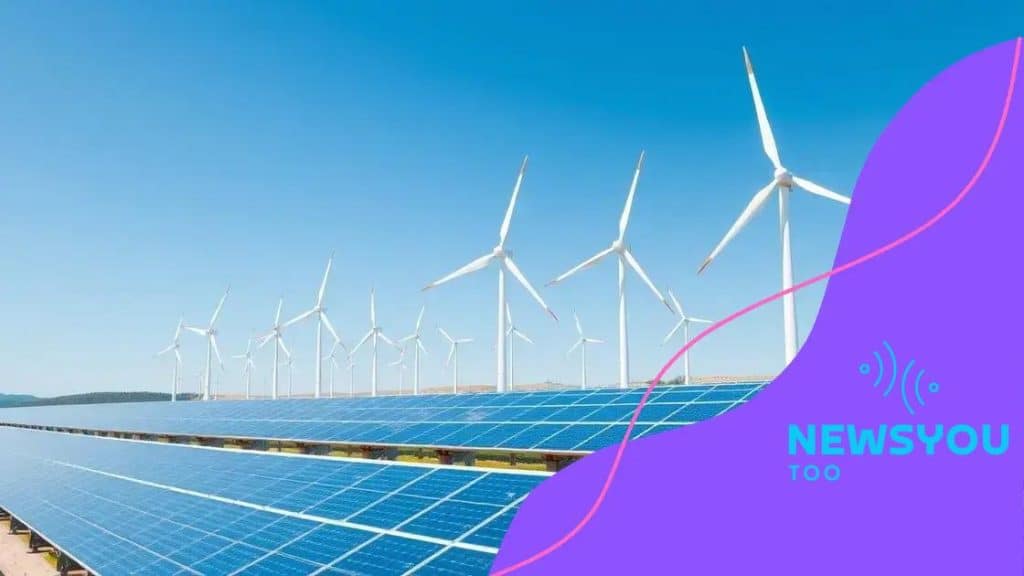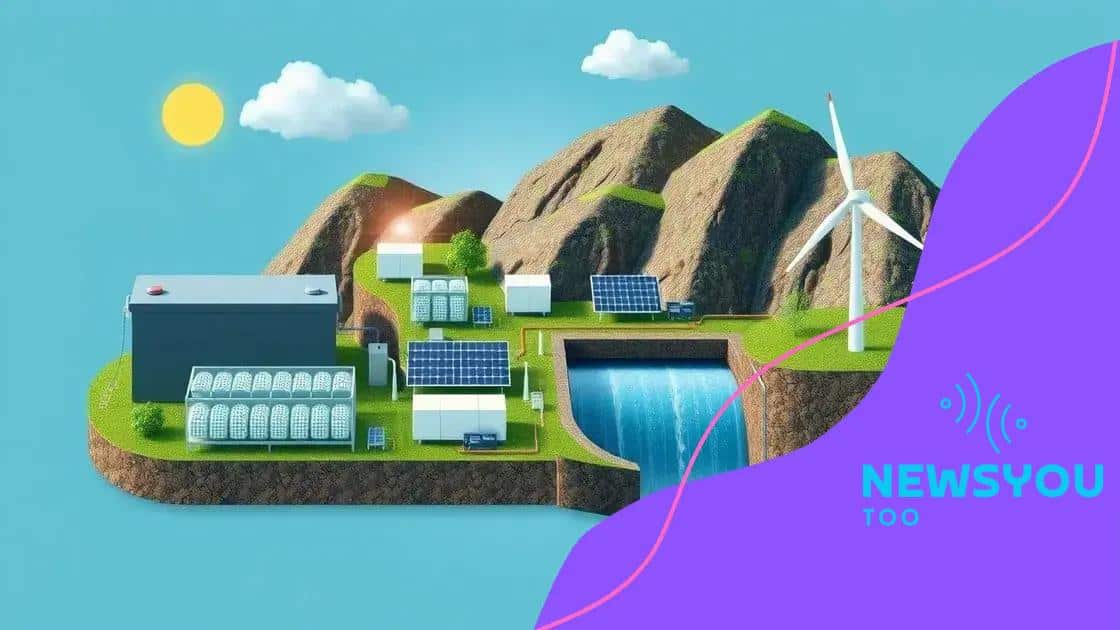Advances in renewable energy technologies in 2025

Anúncios
Advances in renewable energy technologies in 2025 include innovations in solar panels, next-gen wind turbines, improved energy storage solutions, and smart grids, all supported by government policies to create a more sustainable energy future.
Advances in renewable energy technologies in 2025 promise to change the landscape of sustainable energy. As we look ahead, it’s exciting to think about how these innovations can reshape our world. Are you curious about what these technologies might mean for our future?
Anúncios
Breakthrough solar panel innovations
In the world of renewable energy, breakthrough solar panel innovations are paving the way for a cleaner future. As technology advances, these innovations play a crucial role in making solar energy more efficient and accessible. One major development is the use of new materials that can significantly enhance solar panel efficiency. For instance, perovskite solar cells are emerging as a game-changer, allowing for higher energy conversion rates at lower costs. Innovations in nanotechnology are also improving light absorption and durability, which means solar panels can last longer and produce more energy. Recent advancements have made solar panels much more efficient. With the latest technologies, panels can now convert over 25% of sunlight into usable electricity. This allows for more energy production from the same surface area, making solar installations more effective and viable. Additionally, advances in tracking systems have enabled solar panels to follow the sun, maximizing exposure throughout the day. Furthermore, these innovations are accompanied by more affordable options for consumers. With decreasing installation costs and accessible financing options, many households are considering solar energy as a practical choice. Green technology has never been more accessible, making it an exciting time for those looking to harness the power of the sun. As we move forward, the future of solar energy looks bright. With continuous research and development, new innovations in solar panel technology will keep emerging, pushing us towards a more sustainable energy future.
Next-gen wind turbines and their efficiency gains
The advancement of next-gen wind turbines has transformed the landscape of renewable energy. These modern turbines are designed to be more efficient and powerful, harnessing the wind’s energy like never before.
Innovative Designs
One of the most exciting aspects of the latest wind turbine technology is the innovative designs being introduced. For instance, vertical axis wind turbines are gaining popularity because they can capture wind from any direction. This flexibility not only enhances efficiency but also reduces the need for complex gear systems.
Anúncios
Enhanced Blade Technology
New materials and engineering techniques are allowing for longer, lighter blades that can capture more wind energy. These advanced blades increase the turbine’s efficiency and energy output significantly, enabling the production of more electricity with less environmental impact. Manufacturers are testing blades made from composite materials that are both strong and lightweight, maximizing performance.
Smart Technology Integration
- Smart sensors that optimize performance and monitor conditions.
- Data analytics for predictive maintenance, reducing downtime.
- Remote monitoring to ensure system efficiency and safety.
- Automated adjustments to blade angles for maximum energy capture.
Moreover, the integration of smart technology allows for better performance monitoring and maintenance. With smart sensors, operators can track the turbine’s condition in real-time, leading to quick responses to any issues. This proactive approach helps maintain high energy output and minimizes operational costs.
As we embrace these advancements, the potential of next-gen wind turbines to deliver clean energy continues to rise. Not only do they offer substantial efficiency gains, but they also represent a step towards a more sustainable energy future for our planet.
The rise of energy storage solutions

The rise of energy storage solutions is reshaping how we think about renewable energy. As more energy comes from sources like solar and wind, having efficient storage systems is key to utilizing that energy when it’s needed the most.
Types of Energy Storage
There are several types of energy storage solutions that are gaining popularity. Battery storage is perhaps the most well-known. Advances in lithium-ion batteries have made them more efficient and affordable. These batteries can store energy generated during peak sunlight or wind and make it available during low production times.
Alternative Storage Methods
Besides batteries, other methods like pumped hydro storage and compressed air energy storage are also being explored. Pumped hydro works by moving water between two reservoirs at different elevations. When energy is needed, the water flows down, turning turbines to generate electricity. Compressed air energy storage involves compressing air in underground caverns. When energy demand rises, the air is released to drive turbines.
Benefits of Energy Storage
- Increases energy reliability by balancing supply and demand.
- Reduces reliance on fossil fuels, lowering carbon emissions.
- Enhances grid stability during peak demand periods.
- Allows for greater integration of renewable energy sources.
With these innovations, energy storage solutions not only help in managing supply but also play a crucial role in reducing greenhouse gas emissions. As technology advances, we can expect energy storage to become more efficient and accessible, further supporting a transition to a sustainable energy future.
Smart grids and their impact on energy distribution
Smart grids represent a groundbreaking shift in how energy is distributed. These advanced systems enhance the reliability and efficiency of electric networks by integrating digital technology. By enabling real-time communication, smart grids make it easier to manage energy supply and demand.
How Smart Grids Work
At their core, smart grids utilize smart meters and sensors to collect data on energy use patterns. This data helps utilities predict demand more accurately and respond to issues quickly. For example, if a disruption occurs, smart grids can reroute power automatically, ensuring minimal downtime for consumers.
Benefits of Smart Grids
- Better management of intermittent energy sources like solar and wind.
- Enhanced energy efficiency for consumers and utilities.
- Reduction in energy waste and lower electricity costs.
- Improved outage detection and response.
Smart grids also empower consumers by providing them with more information about their energy usage. Homeowners can monitor their electricity consumption in real-time, making it easier to identify opportunities for savings. This increased awareness fosters a culture of energy conservation.
Moreover, smart grids support the integration of electric vehicles and other renewable energy technologies, making it easier to transition to cleaner energy sources. As we move towards a more sustainable future, the importance of smart grids in managing and distributing energy cannot be understated.
Government policies shaping renewable energy’s future
Government policies play a vital role in shaping the future of renewable energy. By providing support and incentives, governments can encourage the development and adoption of clean technologies.
Incentives for Renewable Energy
Many countries offer various incentives to promote renewable energy usage. These incentives can include tax credits, grants, and rebates that lower the cost of solar panels or wind turbines for consumers and businesses. Such measures make renewable energy sources more accessible, ultimately increasing their adoption.
Regulations and Standards
Regulations are essential for ensuring that renewable energy systems are safe and efficient. Governments set standards for energy production and establish guidelines for installation practices. This helps ensure that new technologies meet safety and performance requirements, which builds public trust in renewable energy systems.
The Push for Clean Energy Goals
- Commitment to reduce greenhouse gas emissions.
- Setting renewable energy targets for a specified percentage of energy generation.
- Investing in research and development of new technologies.
- Facilitating community engagement in renewable energy projects.
Governments worldwide are also committing to ambitious clean energy goals. Many countries aim to achieve net-zero emissions by 2050, which involves a significant shift away from fossil fuels. This commitment leads to investments in renewable energy infrastructure and research, making innovative technologies a reality.
In addition, as more cities and communities push for local renewable energy projects, government support becomes crucial in facilitating these initiatives. By empowering local efforts, policy makers can help ensure that renewable energy achieves its full potential in combating climate change.
Conclusion: The advancements in renewable energy technologies, such as breakthroughs in solar panels, next-gen wind turbines, energy storage solutions, smart grids, and supportive government policies, position us on the path to a sustainable future. By embracing these innovations, we can reduce our environmental impact, create a more reliable energy grid, and empower individuals and communities to participate in the transition to clean energy. Together, these elements not only mitigate climate change but also help build an energy system that is resilient, efficient, and equitable for all.
FAQ – Frequently Asked Questions about Renewable Energy Technologies
What are the main benefits of using renewable energy?
Renewable energy reduces greenhouse gas emissions, enhances energy security, and decreases dependence on fossil fuels, leading to a healthier planet.
How do advancements in solar technology improve energy efficiency?
New materials and designs, such as perovskite solar cells, increase energy conversion rates, making solar energy more efficient and affordable.
What role do government policies play in renewable energy adoption?
Government policies provide incentives like tax credits and grants, encouraging the implementation and growth of renewable energy sources.
Why are smart grids important for energy distribution?
Smart grids allow for real-time data on energy usage, improving reliability and efficiency by optimizing energy distribution to meet demand.





